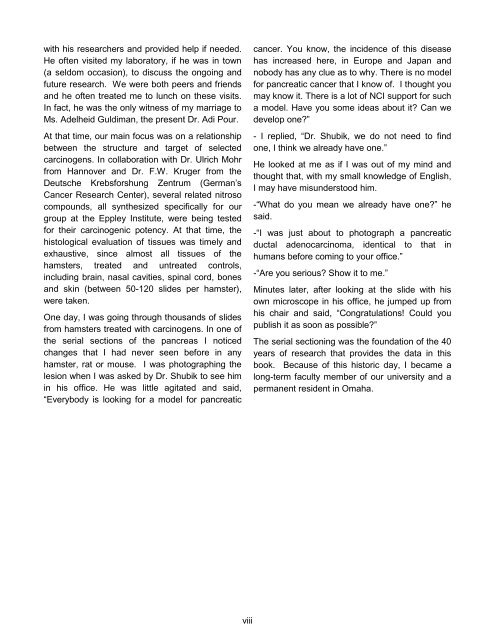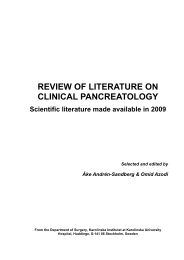Download PDF - The Pancreapedia
Download PDF - The Pancreapedia
Download PDF - The Pancreapedia
Create successful ePaper yourself
Turn your PDF publications into a flip-book with our unique Google optimized e-Paper software.
with his researchers and provided help if needed.<br />
He often visited my laboratory, if he was in town<br />
(a seldom occasion), to discuss the ongoing and<br />
future research. We were both peers and friends<br />
and he often treated me to lunch on these visits.<br />
In fact, he was the only witness of my marriage to<br />
Ms. Adelheid Guldiman, the present Dr. Adi Pour.<br />
At that time, our main focus was on a relationship<br />
between the structure and target of selected<br />
carcinogens. In collaboration with Dr. Ulrich Mohr<br />
from Hannover and Dr. F.W. Kruger from the<br />
Deutsche Krebsforshung Zentrum (German’s<br />
Cancer Research Center), several related nitroso<br />
compounds, all synthesized specifically for our<br />
group at the Eppley Institute, were being tested<br />
for their carcinogenic potency. At that time, the<br />
histological evaluation of tissues was timely and<br />
exhaustive, since almost all tissues of the<br />
hamsters, treated and untreated controls,<br />
including brain, nasal cavities, spinal cord, bones<br />
and skin (between 50-120 slides per hamster),<br />
were taken.<br />
One day, I was going through thousands of slides<br />
from hamsters treated with carcinogens. In one of<br />
the serial sections of the pancreas I noticed<br />
changes that I had never seen before in any<br />
hamster, rat or mouse. I was photographing the<br />
lesion when I was asked by Dr. Shubik to see him<br />
in his office. He was little agitated and said,<br />
“Everybody is looking for a model for pancreatic<br />
viii<br />
cancer. You know, the incidence of this disease<br />
has increased here, in Europe and Japan and<br />
nobody has any clue as to why. <strong>The</strong>re is no model<br />
for pancreatic cancer that I know of. I thought you<br />
may know it. <strong>The</strong>re is a lot of NCI support for such<br />
a model. Have you some ideas about it? Can we<br />
develop one?”<br />
- I replied, “Dr. Shubik, we do not need to find<br />
one, I think we already have one.”<br />
He looked at me as if I was out of my mind and<br />
thought that, with my small knowledge of English,<br />
I may have misunderstood him.<br />
-“What do you mean we already have one?” he<br />
said.<br />
-“I was just about to photograph a pancreatic<br />
ductal adenocarcinoma, identical to that in<br />
humans before coming to your office.”<br />
-“Are you serious? Show it to me.”<br />
Minutes later, after looking at the slide with his<br />
own microscope in his office, he jumped up from<br />
his chair and said, “Congratulations! Could you<br />
publish it as soon as possible?”<br />
<strong>The</strong> serial sectioning was the foundation of the 40<br />
years of research that provides the data in this<br />
book. Because of this historic day, I became a<br />
long-term faculty member of our university and a<br />
permanent resident in Omaha.












